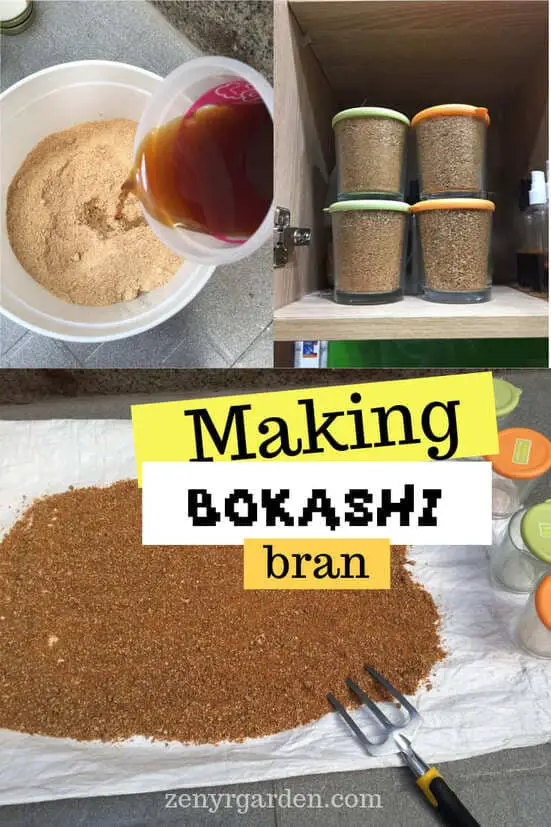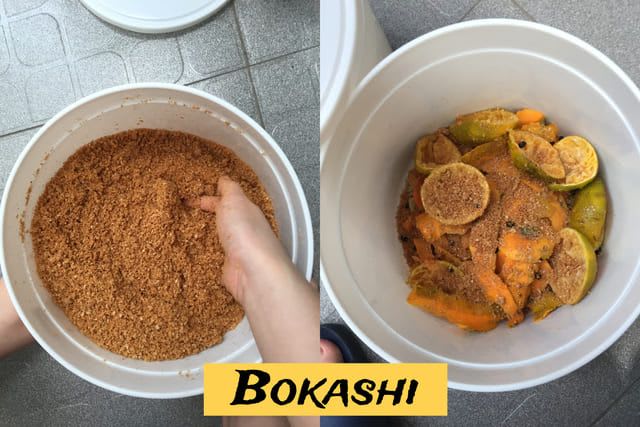If you've already made your own EM or have store-bought ones, then making bokashi bran is relatively a simple process.
Here are the ingredients we need and a little note about what EM is:
What is EM
EM, or effective micro-organisms, are the combination of different kinds of beneficial microbes to help bring out good results in less time, less cost, and with sustainable effectiveness or repeated applications.
People have seen much bigger, faster growth with their plants with some microbes mixed in. In chicken coops, it helps reduce smell, stops lice infestation and aids chicken digestion.
Making bokashi bran is a way to capture these microbes in a form that can be stored for a longer time even without refrigeration and then later used.
You need EM to make the bokashi bran in this post. It can be bought or homemade. If you want to make it yourself, you can follow the instructions here to get started --> How to make EM at home easily
Ingredients:
- 500ml / 2 cups water
- 15ml / 1 tbsp EM
- 15ml / 1 tbsp molasses
- 1 kg / 2 lbs bran
/prepare-ingredients.jpg)
For the bran or the 'carrier' of the EM, you can also use newspaper, rice bran, rye bran, oat bran, cornmeal, sawdust or any other inert materials.
In Canada, it may be hard to find rice bran/wheat bran, so those are the alternatives you could use. Here we'll be using soybean bran.
If you use rice bran, prepare some wheat flour to throw in so it doesn't clump up in the process of mixing.
Now we can start with:
Making Bokashi Bran
When you have all the ingredients ready, we can begin our first step which is...
Step 1: Mix EM + Molasses With Water
Measure out 15 ml EM and 15 ml molasses. Pour both into 500ml of water and stir well.
/step-01-mix-em-molasses-with-water.jpg)
After mixing the EM and molasses, it will look something like this:
/step-01-before-after-mixing.jpg)
The next step we'll do is:
Step 2: Mix Our Solution With the Bran
Dump 1 kg bran into a container. Then pour the solution we've just made (about 500+ ml) in with the bran. Mix it well.
/step-02-mix-solution-with-bran.jpg)
At first, it may feel like it's too wet or we've put in too much liquid. However keep on mixing, especially the bottom part so there is no dry spot.
The absorption rate of the bran may also depend on its age. As more bran absorbs the liquid, it will turn out nice and well-incorporated.
This is probably the most time-consuming part of the process if you're hand-mixing.
To quickly test if it's moist enough, grab a ball of bran and squeeze it in your hand. If excess liquid drips out too much, it means it's too wet. You can add more bran or keep on mixing it more.
However, if it forms a nice shape and crumbles when you break it, then it's good enough.
/step-02-test-the-moisture.jpg)
And you're basically done!
The done mixture has a very nice smell like that of tomato juice in my case and a beautiful golden brown color like cookie crumble.
Step 3: Further Fermenting, Drying & Storing
From here, you can put the bran somewhere dark and warm in an airtight container. Let it ferment for another 2-3 weeks in the summer or 4-6 weeks in the winter.
After 2 weeks, take some out to check how it's progressing. The bran should have a nice pleasant fermented smell. If there is some white fuzz on top, it's absolutely fine.
/happening-of-bokashi-bran-10-days.jpg)
For me, on day 2 that I checked, the batch smelled a bit like tofu. I guess it's because I used soybean bran. And 10 days in, it developed this thin white coating on top and smelled nice. Not anything unpleasant at all.
However, if you notice that it smells acrid or horrid, then something might have gone wrong. It may be either the mixture is too wet or the container is not airtight. In this case, start over and get a new batch going.
Drying
If the bokashi turns out good, you can take it out and spread it thinly on a surface to dry.
/drying-bokashi-bran.jpg)
Dry it in a brightly lit place but avoid strong direct sunlight as the heat or strong UV rays could kill the microbes.
When dried, store the bokashi bran in an airtight container. The bran will be good for up to 2 years.
/bokashi-bran-done.jpg)
Be sure to dehydrate it in a good clean place, so other contamination won't affect your bran.
/some-contamination-in-bokashi-bran-after-drying.jpg)
This drying process will take the water moisture out of the bokashi. It will put the microbes into sleep mode. When taken out to use, the moisture + some heat will wake the microbes up again.
With the bokashi bran made, you can take some to use for your next gardening needs.
But... I wonder
Why Further Ferment and Not Use Right Away?
For this I noticed that when left open and exposed to air in a dark place, the bran gets really hot. Up to 43C (~110F).
/heat-of-microbes-temperature.jpg)
When touching the glass jar, I thought the heat of the underneath stove was heating it up. But no, it was the microbes I guess somehow!
This lasted for about a day. After that the jar cooled down. There was no smell at first. But some time later, it did leave a weird smell.
When used in a bokashi bucket with some fruits and veggies, it smelled a bit like acetone. If I recall correctly, the white bloom did not appear much at all, stopped or grew very slowly.
An interesting thing I noticed, the temp point 43C (110F) is also the point recommended for starting & making yogurt. It's also the point beyond which, in something like the black soldier fly BSF insect farming, the little worms or larvae (or may be the microbes on their skin) may not survive. So this does leave some room to ponder upon. Some I have in mind are:
- Does starch excite (activate) the microbes that much?
- Is the heat relative to the oxygen?
- Could they be used as heat generators (where some warmth is needed)?
- Are the microbes in this thing and on the BSF skin similar?
And so on...
The one thing I wouldn't repeat for my next batch is to leave the just-finished-mixing bran exposed to air. Either we can use it right away in a container lid closed, or dry it then store for longer usage. Works really well from what I've seen.
Anyway, going back to our bokashi usage, you can start:
Using Bokashi
1. For Composting
If you want to use the bran for composting, you can add in a bottom layer of bokashi bran in a container. Then, throw in some food scraps.
/sprinkling-bokashi-bran-into-bucket.jpg)
If you're generous, sprinkle some more bran on top. This can help keep the smell down especially for higher-protein foods.
Then close the lid tightly, let the microbes do their thing & enjoy the results.
Here are some updates on such usage of bokashi for composting:
After one day, we can see some white fuzz or bloom developing.
/white-fuzz-development-bokashi.jpg)
My guess is those are the blooms of the Lactobacillus, not the mycelium (white strings) of fungi though as I didn't put any fungi in.
Lactobacillus Short Story
Lactobacillus, as you may have known it, are wonderful micro-organisms. From the words of Old Gardener Guy - Finland, people did an experiment with Lacto back in Helsinki University where they put E.Coli on agar petri dishes and pipetted different strains of Lactobacillus in and incubated.
After a few days, when taken out of the incubator space, circular structures (some large some small) were observed around the E.Coli. These circular zones stopped the further growth of the E.Coli. They guess the lacto then may have produced some sort of probiotics that could inhibit the growth of the bad guys. Together with their prolific production of polysaccharides, these guys colonize the intestine lining fast, leaving little room for harmful enterobacteria (gut bacteria) to step foot in.
Some white coating developed:
/beautiful-development-lacto-envelopment.jpg)
When extracting the bokashi juice and left in a dark place, the same structure/pattern developed on the top surface of the juice.
/lacto-on-juice-and-organic-matter.jpg)
>> Is this what's inside our stomach lining as we digest foods?? Is this why they call it gut flora, like coral reef blooming inside the stomach. It reminds me of the surface of some architecture. Really beautiful.
20 days after:
/development-after-20-days.jpg)
The bucket on the left is another bucket. I wanted to show you the white bloom development. The bucket on the right is the one we are doing. It has blooms + the white coating structure we've seen before.
For now that's about it for today. Will keep updating you on the results.
You can also use the bran for your chicken coops:
Using Bokashi Bran for Chicken Coop
You could also sprinkle some done bokashi bran around your chicken coop. Basically, the bran acts as a carrier for the little army of microbes to be used in the chick pen. Or you can also use it in a deep litter design. Although the smelly smell may not get eliminated, it can be reduced.
The bran when mixed with chicken drink or feed could help develop good gut bacteria for the chicks.
According to a farmer, it can help boost nutrient absorption rate from about 60% to 80%, meaning the chicks guts may absorb more of the nutrients from the same amount of foods they eat.
In one chicken farm that has about 60k layer hens, the birds were getting lice infestation. They sprayed these LAB guys with fermented plant juice (FPJ) and oriental herb nutrients (OHN) in appropriate proportions recommended by natural farming methods. Within days, the lice disappeared.
As the good bacteria population in your chicken coop increases, it can also drive out the bad guy population. The good microbes can be happy campers then. And we'll have healthier chickens.
>> Link Blog post. You can see more details are here:
A Bokashi Composting Video
For more bokashi instructions, check out this amazing video on bokashi composting, step by step:
Bokashi CompostingThanks:
- Organiko Filipino Farm (for sharing the recipe)
I am thinking... can brewery waste be used for bokashi?
Responses to Readers' Questions
Can I mix bokashi in pig feed? If yes, in what portions?
--> Thanks for your question, good one. Actually I haven't tried experimented with this though, but I'd imagine it could be an interesting experiment. Folks have used bokashi in chicken feed, so it's likely possible too for pigs. I'll ask around and share what I can find. Meanwhile, you could do some of your own testings. Let us know if there are any good results. See you again next time.
Share or pin this post!


